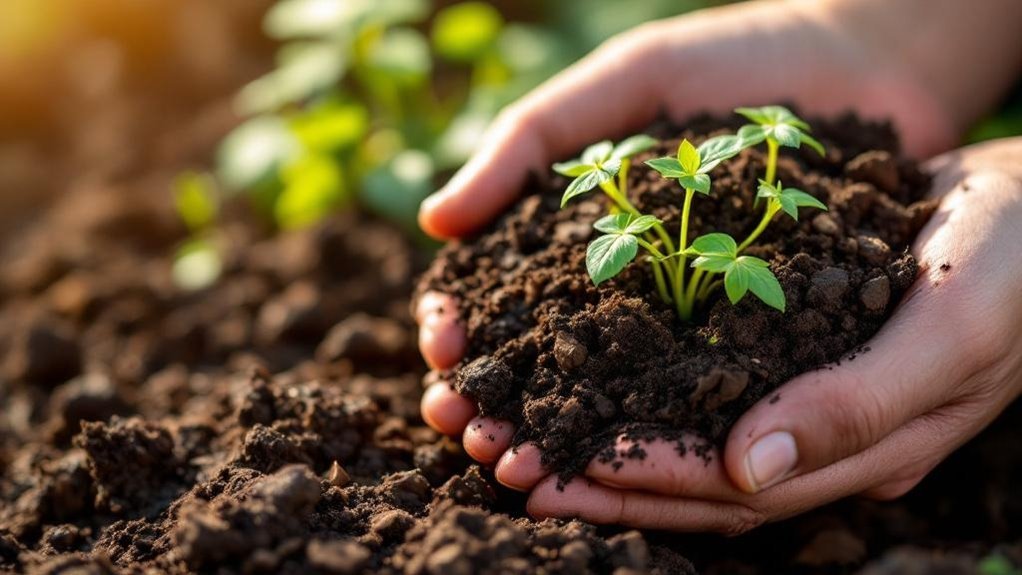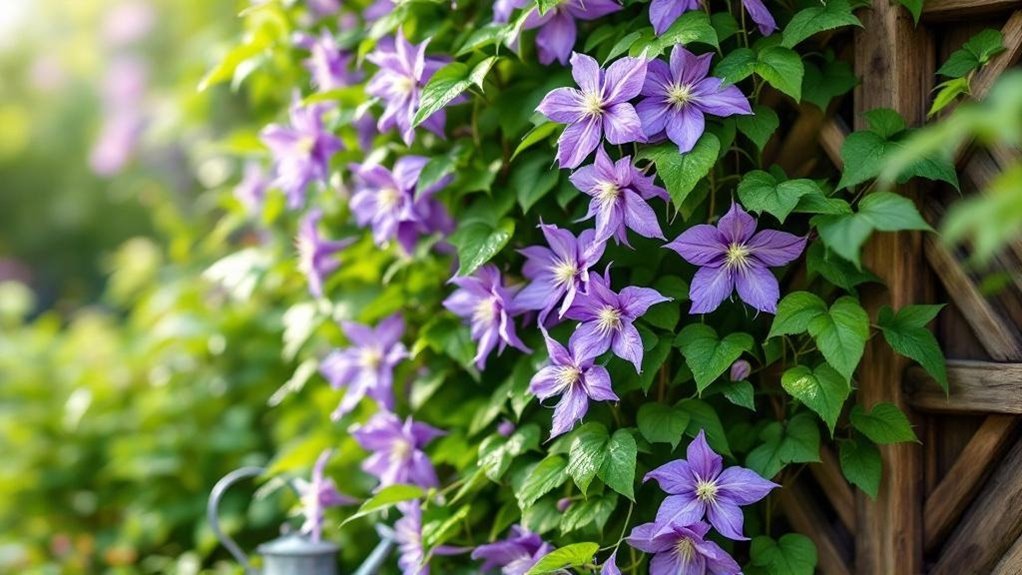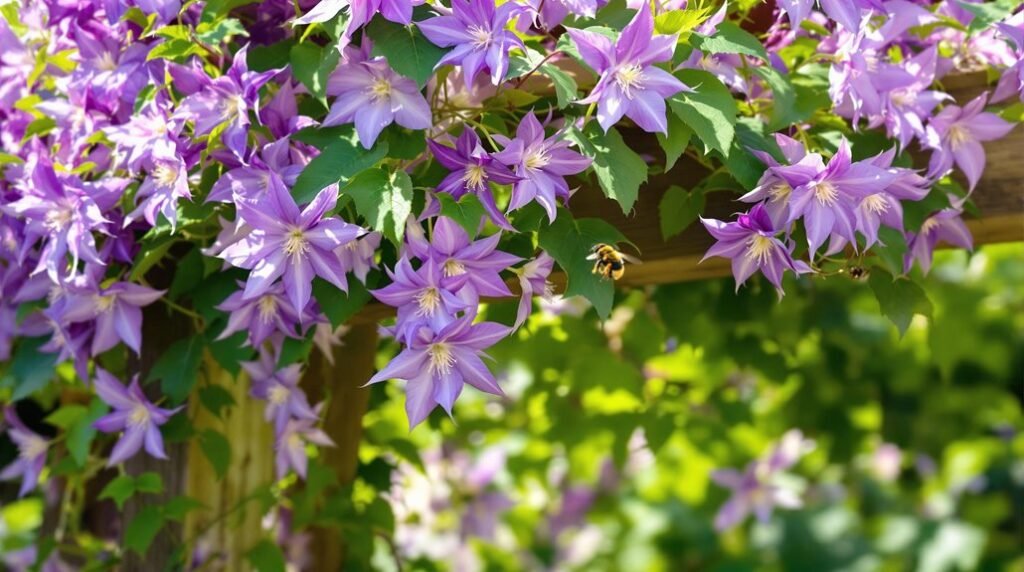You might think growing clematis is too complicated or time-consuming, but with the right approach, it’s quite manageable. These climbing flowers can transform any garden with their vibrant colors and graceful vines. Choosing the right variety, planting it correctly, and knowing how to care for it can make all the difference. Before you decide, consider a few key factors that will help your clematis thrive and bloom beautifully.
Choosing the Right Clematis Variety
How do you pick the perfect clematis for your garden? Start by exploring clematis varieties that suit your space, from vigorous types reaching 25 feet to compact ones ideal for containers.
Next, understand pruning groups: Group 1 blooms on old wood, Group 2 on both old and new wood, and Group 3 blooms on new wood only. This affects flowering times, with some varieties blooming in spring and others extending color into summer or fall.
Consider where your clematis will grow—some thrive in full sun, while others prefer partial shade.
Popular cultivars like Nelly Moser and Jackmanii offer diverse colors and sizes, helping you create a stunning display tailored to your garden’s conditions and style.
Selecting the Ideal Location for Clematis
Once you’ve chosen the right clematis variety, the next step is finding the perfect spot to plant it. Selecting a clematis in the ideal location guarantees vigorous growth and abundant blooms.
Most clematis thrive in full sun, needing at least six hours of direct sunlight daily, though some tolerate partial shade. Focus on well-draining soil rich in organic matter, with a neutral to slightly alkaline pH. Adequate air circulation prevents disease and promotes healthy foliage.
Clematis flourish with six hours of sun, well-drained organic soil, and good air circulation for healthy growth.
Keep these tips in mind when selecting the ideal location:
- Plant clematis at least 30-45 cm from walls or fences for airflow
- Avoid northeast-facing sites due to limited sunlight
- Provide root shade using mulch or companion plants
- Confirm foliage receives warm, direct sunlight for best flowering
This balance creates an environment where your clematis will flourish beautifully.
Preparing the Soil and Planting Techniques

Although selecting the right spot is crucial, preparing the soil properly and using effective planting techniques lays the foundation for your clematis to thrive.
Start by digging a hole three times the width and twice the depth of the root ball, mixing in compost and well-rotted manure to create nutrient-rich conditions.
Make sure the soil is well-drained and rich in organic matter to support healthy roots and strong root development.
Plant your clematis at a 45-degree angle toward the support, burying the crown 3 to 4 inches below soil level. This encourages stability as your climbing flowers grow.
After planting, water thoroughly to settle the soil and maintain regular watering during the first season, avoiding waterlogging to establish a robust root system.
Supporting and Training Your Clematis
After planting your clematis securely in nutrient-rich soil, you’ll want to provide a strong support system to guide its growth. A sturdy support structure like a trellis or support structure is crucial for growing clematis vines, as they climb by wrapping their leaf stems around supports.
Make certain your chosen structure is robust enough to accommodate vigorous growth and add vertical interest to your garden. When training your clematis, secure the climbing vines gently with ties or clips, allowing room for expansion without damaging stems.
To keep your clematis thriving, regularly check and maintain supports. Remember, a healthy clematis vine also depends on encouraging strong root development.
- Use trellises, arbors, or fences for climbing support
- Secure vines with flexible ties or clips
- Verify supports can handle mature plant size
- Regularly inspect and repair structures as needed
Watering and Fertilizing Requirements

Because clematis needs consistent moisture to establish strong roots, you should water deeply once a week, especially during its first growing season. Use deep watering techniques to maintain even soil moisture without causing root rot. Plant clematis in well-draining, organic-rich soil and apply a balanced fertilizer in early spring and after the first bloom. Mulching around the base helps retain moisture and keeps roots cool, which supports healthy growth.
| Task | Frequency | Tips |
|---|---|---|
| Watering | Weekly (deep) | Avoid waterlogged soil |
| Fertilizing | 2-3 times/year | Use slow-release balanced fertilizer |
| Mulching | Annually or as needed | Retains moisture, prevents heat stress |
| Soil Check | Weekly | guarantee well-draining, moist soil |
Pruning Methods for Different Clematis Groups
Since clematis plants belong to three distinct pruning groups, you’ll need to adjust your pruning techniques based on which group your plant falls into. Proper pruning encourages blooms, supports healthy growth, and helps reduce disease like clematis wilt.
Tailor pruning to your clematis group for vibrant blooms, healthy growth, and disease prevention.
- For Group 1, remove only dead or damaged stems after flowering; avoid heavy pruning to protect old wood.
- Group 2 benefits from pruning back one-third of stems in early spring to promote healthy growth and encourage blooms.
- Group 3 requires cutting back to 12-18 inches above ground in late winter to stimulate vigorous growth and prolific summer and fall flowers.
Regular pruning, especially for Groups 2 and 3, improves airflow, rejuvenates plants, and reduces disease risk.
Tailoring your pruning guarantees a thriving, beautiful clematis display year after year.
Managing Common Issues and Pests
Pruning your clematis properly sets the stage for strong, healthy growth, but keeping your plants thriving also means staying alert to common issues and pests.
Clematis wilt, caused by root-rotting fungi, can suddenly blacken and collapse stems; promptly cut off and destroy affected parts to stop its spread.
Powdery mildew thrives in poor air circulation, so spacing clematis adequately and avoiding wetting foliage helps prevent it.
Maintain evenly moist soil to reduce environmental stress, which weakens plants and invites problems.
Watch for common pests like aphids and vine weevil larvae; healthy plants resist infestations better, but insecticidal soaps work well if needed.
Frequently Asked Questions
Which Is the Most Beautiful Clematis?
You’ll find beauty in all clematis varieties, but if you want striking, large pink blooms, Nelly Moser stands out. Its impressive size and color will definitely catch your eye in any garden setting.
Where Is the Best Place to Plant a Clematis?
You’ll want to plant clematis where it gets at least 6 hours of sunlight daily, as they bloom best then. Keep roots cool with mulch, avoid northeast sides, and space them 30-45 cm from walls or fences.
What Are the Cons of Clematis?
You’ll face challenges like clematis wilt, invasive growth in some types, and the need for sturdy supports. Plus, pruning can be tricky, and they’re prone to stress and mildew if conditions aren’t ideal, so plan carefully.
How to Make Clematis Bloom All Summer?
You’ll see clematis bloom all summer when you prune Group 2 varieties correctly, water consistently during dry spells, and fertilize 2-3 times. Plant with companions blooming at different times to keep your garden vibrant and full.
Final Thoughts
Now that you’ve learned the secrets to growing clematis, imagine the vibrant blooms transforming your garden from spring through fall. But here’s the twist—your success hinges on one simple step you might overlook. Will you give your clematis the right support and care it truly needs? Take that next move, and watch as your garden bursts into a stunning vertical masterpiece. The reward? Beauty that’s well worth the wait.
